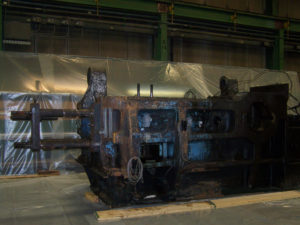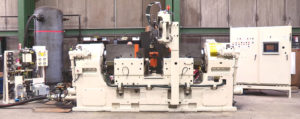In an era where equipment is routinely rendered obsolete at an ever-increasing pace, forging equipment stands alone as machines built to work on a daily basis for decades – if not the better part of a century. Their built-to-last roots are from a bygone industrial era and their longevity is a testament to the quality of the original design and build.
It is a combination of good design, manufacturing quality control and correct operation of equipment that makes it possible for it to work so long. Good design begins with the OEM that builds forging equipment using sound mechanical design principles along with proper material grade selection and correct heat treatment specifications for internal component parts. This is also critical knowledge for future repair or rebuilds of forging equipment. While an operator has the responsibility to operate the equipment correctly, no matter how well it is maintained, the high impact nature of forging will eventually take its toll over time. When this occurs, parts will need to be replaced, and a rebuild may be necessary to extend the life of the forger. At that point, the choice is either to contact the OEM to do the work or contract with a third-party rebuilder. The decision is significant, given the need for a correct, complete and dependable repair or rebuild that will perform as expected for many years.
Rebuilders Emerge
 Over the decades, as some OEMs focused more on new equipment sales, many forgers turned to third-party rebuilders for parts and service. Today, rebuilders also play an important role in the used forging equipment market, where they often go to auctions to acquire a machine they can repair and re-sell. To repair or rebuild equipment, many rebuilders use a reverse engineering process to create their own parts or have them machined at local CNC shops. Although this approach may work in the short term to “get the equipment up and running,” it ignores the long-term view. In addition, rebuilders with experience working on a variety of other types of equipment, such as stamping presses or injecting molding machines, may not fully appreciate the forces exerted during the forging operation. “When an independent rebuilder reverse engineers a part, considerable amount of critical engineering design data is lost resulting in inferior part construction and premature wear or component failure,” says Ken Copeland, President of Ajax-CECO-Erie Press. “Often they are rebuilding a machine without really understanding the original design intent or the loads that will be placed on the parts and equipment.” Copeland admits that due to mergers and acquisitions, along with some OEMs going out of business, repair business has been pushed in the direction of rebuilders. However, the large OEMs that remain have re-dedicated their efforts to providing parts manufactured to the original design specs along with repair services with quicker turnaround at a competitive cost.
Over the decades, as some OEMs focused more on new equipment sales, many forgers turned to third-party rebuilders for parts and service. Today, rebuilders also play an important role in the used forging equipment market, where they often go to auctions to acquire a machine they can repair and re-sell. To repair or rebuild equipment, many rebuilders use a reverse engineering process to create their own parts or have them machined at local CNC shops. Although this approach may work in the short term to “get the equipment up and running,” it ignores the long-term view. In addition, rebuilders with experience working on a variety of other types of equipment, such as stamping presses or injecting molding machines, may not fully appreciate the forces exerted during the forging operation. “When an independent rebuilder reverse engineers a part, considerable amount of critical engineering design data is lost resulting in inferior part construction and premature wear or component failure,” says Ken Copeland, President of Ajax-CECO-Erie Press. “Often they are rebuilding a machine without really understanding the original design intent or the loads that will be placed on the parts and equipment.” Copeland admits that due to mergers and acquisitions, along with some OEMs going out of business, repair business has been pushed in the direction of rebuilders. However, the large OEMs that remain have re-dedicated their efforts to providing parts manufactured to the original design specs along with repair services with quicker turnaround at a competitive cost.
No one know its equipment better than is manufacturer
 A prime example is Ajax-CECO-Erie Press, which has merged leading brands Chambersburg (CECO), Ajax Manufacturing and Erie Press Systems under the Park Ohio parent company. Today, the company is the largest forging equipment manufacturer in North America and services the original products of all three companies with the strength of their combined engineering resources and field services. OEMs such as Ajax-CECO-Erie Press remain the repository of detailed forging equipment knowledge which is a key consideration for repairing or rebuilding a forger. “No one knows the equipment like the OEM,” says Copeland. “The OEM has the original design specifications. It is essential information as it pertains to the design principles, engineering data, critical component specifications and is fundamental to an understanding of what the equipment was originally designed and built to do.” Information such as the design specifications, including critical data on high-wear parts, the material grade of the steel, the heat-treating process that was used, and the required clearances that were used in the engineering of that particular forger are all needed for a quality repair or rebuild. Age and modifications over an equipment’s operating life can obscure this information making it difficult for a rebuilder to source all the details. For example, if a 60-year old forging machine had a secondary heat treat surface coating as part of the original design specification that later wore off over years of use, it would not be apparent to a rebuilder. Not adding a replacement surface coating during a repair or rebuild could then compromise the longevity of the repair. Whereas the OEM keeps documentation on all modifications which will later be reviewed when replacing parts. “Given the decades of use there are a lot of different purpose-built forgers in the market,” said Copeland. “While common forger knowledge can be amassed just by working in the industry, it is not possible for a rebuilder to know each brand and type of forger at the same level. This is what can end up costing an operator over time.” Without the benefit of the original design specifications, there is the risk of a wrong or sub-optimal part being used in the repair or rebuild. Given the loads placed on a forger, even minor material changes can make a major difference in equipment longevity. Consider that forging equipment has to take the highest impact and accept the highest pressure of any type of metal forming equipment. Simple things like the size and placement of a corner radius can affect the longevity of a component. There is also the risk of working with a rebuilder who takes short cuts. Said Copeland, “A conscientious rebuilder will try to reverse engineer how the forger was built which may lead them to contact the OEM to source the correct part. But there are also shops who will just apply a fresh coat of paint and not do all the work needed.”
A prime example is Ajax-CECO-Erie Press, which has merged leading brands Chambersburg (CECO), Ajax Manufacturing and Erie Press Systems under the Park Ohio parent company. Today, the company is the largest forging equipment manufacturer in North America and services the original products of all three companies with the strength of their combined engineering resources and field services. OEMs such as Ajax-CECO-Erie Press remain the repository of detailed forging equipment knowledge which is a key consideration for repairing or rebuilding a forger. “No one knows the equipment like the OEM,” says Copeland. “The OEM has the original design specifications. It is essential information as it pertains to the design principles, engineering data, critical component specifications and is fundamental to an understanding of what the equipment was originally designed and built to do.” Information such as the design specifications, including critical data on high-wear parts, the material grade of the steel, the heat-treating process that was used, and the required clearances that were used in the engineering of that particular forger are all needed for a quality repair or rebuild. Age and modifications over an equipment’s operating life can obscure this information making it difficult for a rebuilder to source all the details. For example, if a 60-year old forging machine had a secondary heat treat surface coating as part of the original design specification that later wore off over years of use, it would not be apparent to a rebuilder. Not adding a replacement surface coating during a repair or rebuild could then compromise the longevity of the repair. Whereas the OEM keeps documentation on all modifications which will later be reviewed when replacing parts. “Given the decades of use there are a lot of different purpose-built forgers in the market,” said Copeland. “While common forger knowledge can be amassed just by working in the industry, it is not possible for a rebuilder to know each brand and type of forger at the same level. This is what can end up costing an operator over time.” Without the benefit of the original design specifications, there is the risk of a wrong or sub-optimal part being used in the repair or rebuild. Given the loads placed on a forger, even minor material changes can make a major difference in equipment longevity. Consider that forging equipment has to take the highest impact and accept the highest pressure of any type of metal forming equipment. Simple things like the size and placement of a corner radius can affect the longevity of a component. There is also the risk of working with a rebuilder who takes short cuts. Said Copeland, “A conscientious rebuilder will try to reverse engineer how the forger was built which may lead them to contact the OEM to source the correct part. But there are also shops who will just apply a fresh coat of paint and not do all the work needed.”
Safety in mandatory
The cost of having an incomplete or incorrect repair ultimately is born by the operator. Forging performance may be sub-optimal, the forger may operate less efficiently, and the life of the equipment may be shortened. Often there is no warranty offered on the repair or rebuild. Importantly there can also be operator safety risk and OSHA compliance issues too. Moreover, with large spare part inventories, choosing an OEM can reduce service times as compared to going to a rebuilder that would first need to purchase a piece of steel and then machine it. The parts and the rebuild are also backed with a warranty from the OEM. Working with an OEM also gives an operator the option to consider replacing their forger rather than rebuilding. Today’s modern forging equipment benefit from automation and modern options added to deliver enhanced efficiencies. They also are built to comply with all required safety regulations without a need to retrofit. “Despite the savings of having an older machine rebuilt, it may not capture the savings in efficiency, operation and safety features that a new machine would accommodate with all the automated and modern options available in the 21st century,” says Copeland. Whether new or rebuilt, a forger is a significant investment for a manufacturer. Maintained correctly, the equipment will provide decades of productivity. How long that lifespan ends up being is dependent upon how well the forger is maintained. Selecting an OEM for a repair or rebuild gives an operator the confidence that the work will be based on the specifications unique to the machine backed by the people that originally built it.



